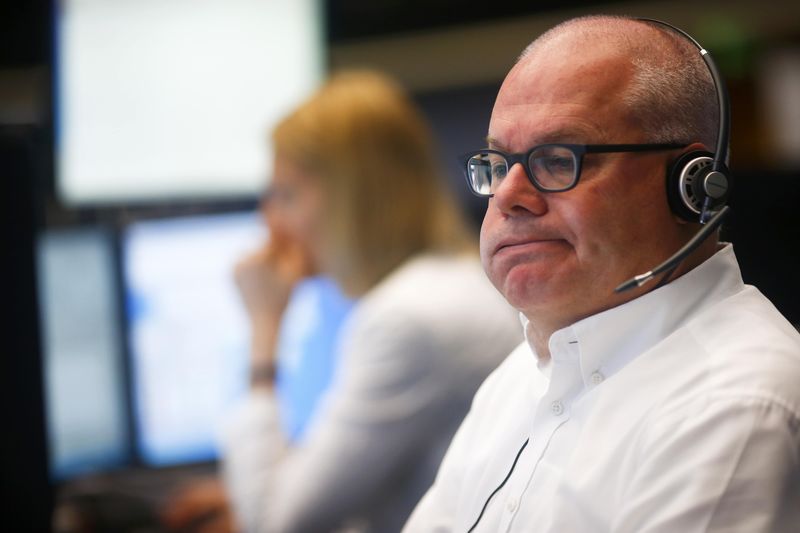* Trump to impose 10% tariffs on rest of U.S. imports from China
* Interest rate futures price in Fed rate cut in Sept
* Yen marks biggest gain in 2 years, gold near 6-year high
* U.S. stock futures down 0.4%, European futures down 1.9%
By Hideyuki Sano and Tomo Uetake
TOKYO, Aug 2 (Reuters) - Global stocks took another beating on Friday with investors piling into safe-haven assets after U.S. President Donald Trump said he would slap a 10% tariff on the remaining $300 billion of Chinese imports starting Sept. 1.
MSCI's broadest index of Asia-Pacific shares outside Japan .MIAPJ0000PUS fell 1.6% to its lowest since mid-June while Japan's Nikkei .N225 tumbled 2.4%.
Chinese stocks were also hit hard, with the benchmark Shanghai Composite .SSEC and the blue-chip CSI300 .CSI300 down 1.5% and 1.6%, respectively, while Hong Kong's Hang Seng .HSI dropped 2.2%.
U.S. stock futures ESc1 slipped 0.4% in Asian trade after the S&P 500 .SPX skidded 0.9% to hit one-month lows overnight, while Pan-European Euro Stoxx 50 futures STXEc1 shed 1.9%.
Trump's announcement, which came a day after U.S. and Chinese negotiators concluded a meeting in Shanghai without significant signs of progress, marks an end to a truce in the trade war struck in June and could further disrupt global supply chains.
"After the U.S.-China summit meeting, people had expected there would be a lull for quite some time," said Masahiro Ichikawa, senior strategist at Sumitomo Mitsui DS Asset Management.
"And the market was also relieved by signs of recovery in the semi-conductor sector. But now investors and companies will have to revise their such scenarios."
China's state media quickly denounced the move, with the editor in chief of the Global Times saying on Friday that a trade deal between the United States and China was now "further away." war of words appeared to escalate after U.S. Secretary of State Mike Pompeo said "decades of bad behaviour" from China had hampered free trade and prompted tariffs and other action from Washington. L4N24Y0Q2
The proposed levies triggered a stampede for safe-haven assets, including U.S. bonds, the yen and gold while the Chinese yuan and the Australian dollar hit multi-month lows.
Gold XAU= stood at $1,432.58 per ounce, down 0.9% in Asia after having risen 2.4% on Thursday, staying near a six-year high of $1,453 touched two weeks ago.
The yen edged up to 107.06 on the dollar JPY=EBS after rising 1.3% overnight, its biggest daily gain in more than two years. FRX
The euro also recovered to $1.1075 EUR=EBS , from a two-year low of $1.1027 hit in U.S. trade.
In contrast, the risk sensitive Australian dollar dropped to a seven-month low of $0.6795 AUD=D4 while the yuan slid to its weakest since November 2018, softening by over 0.7% to 6.95 per dollar in onshore trade CNY=CFXS and fell to 6.9563 in the offshore market CNH= .
The 10-year U.S. bond yield fell almost 12 basis points on Thursday to 1.902 percent US10YT=RR , hitting the lowest level since Nov. 8, 2016, when Trump won a surprise victory in the presidential election. The 10-year yield extended its slide to as low as 1.875% in Asian trade.
Trump's decision has thrown the Federal Reserve another curve ball that may force it to again cut interest rates to protect the U.S. economy from trade-policy risks after its first rate cut in more than a decade on Wednesday. Fed Chairman Jerome Powell said the rate cut was a "mid-cycle adjustment" and not a start to a full-blown rate-cutting cycle, markets aren't fully convinced.
The October Fed funds rate futures FFV9 have jumped to now fully price in a rate cut in September, compared with only around 60% before the tariff announcement. Another 25 basis point move is priced in by December.
"In the grand scheme of things, it will become clearer and clearer that the Federal Reserve has started an easing cycle and will have no choice but to cut rates further," said Akira Takei, fund manager at Asset Management One.
The new tariffs would hit a wide swathe of consumer goods from cell phones and laptop computers to toys and footwear, at a time when the manufacturing sector is already reeling from the accumulative impact of the trade war.
The U.S. Institute for Supply Management said on Thursday its index of national factory activity fell to 51.2 last month, the lowest reading since August 2016. That came on the heels of surveys in Europe and Asia showing factories under the pump, with manufacturing activity in many countries shrinking in the face of intensifying trade frictions. prices bounced back a tad after suffering sharp falls the previous day. O/R
Brent crude LCOc1 rose 2.7% to $62.12 per barrel, after having fallen 7.0% on Thursday, its biggest daily percentage drop since February 2016. U.S. West Texas Intermediate (WTI) CLc1 crude rebounded 2.1% to $55.10, having shed 7.9% the previous day. (Editing by Shri Navaratnam and Jacqueline Wong)
